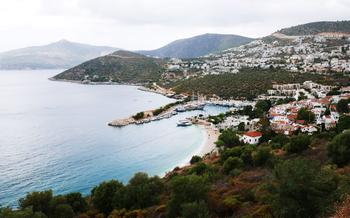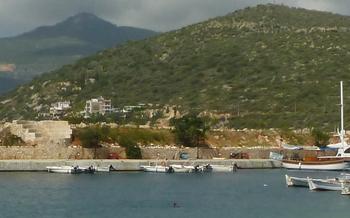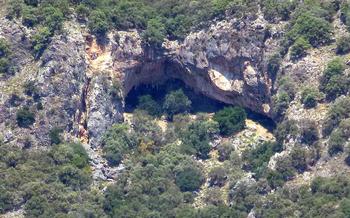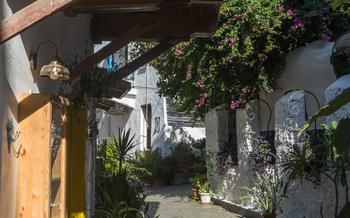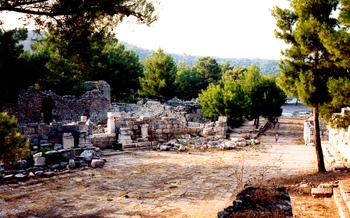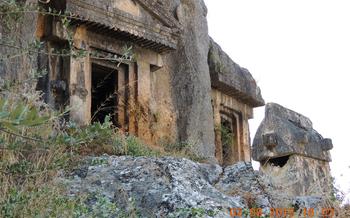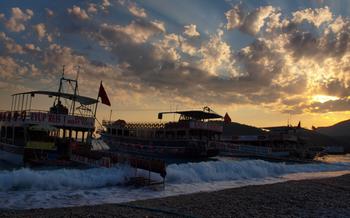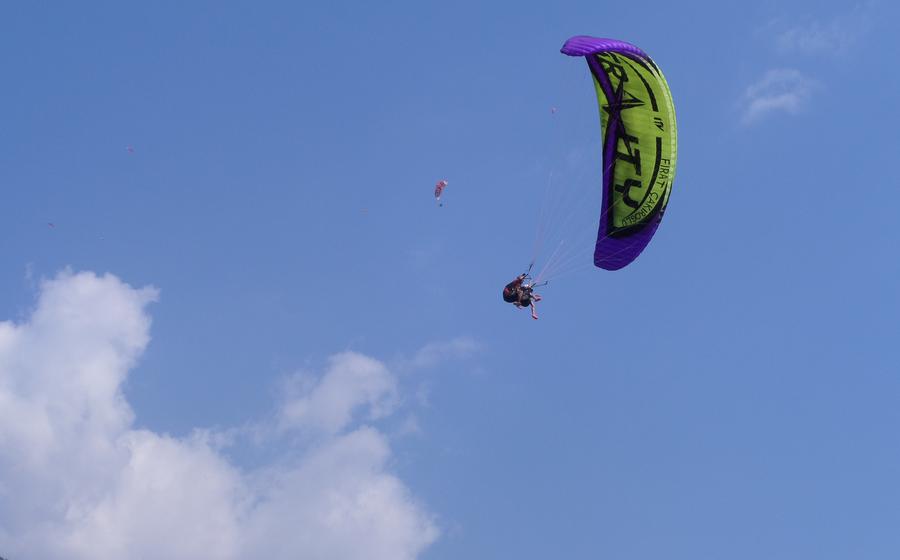
Pinara Ancient City
- Historical Significance
- Getting There
- Entrance Fees and Hours of Operation
- Exploring the Ruins
- The Necropolis
- The Theater
- The Agora
- The Temples
- The Bouleuterion
- The Museum
- Photo Opportunities
- Local Cuisine
- Accommodation
- Souvenirs and Shopping
- Insider Tip
Historical Significance
The ancient city of Pinara, nestled in the picturesque Taurus Mountains, holds a significant place in the history and culture of the Lycian civilization. Once a thriving metropolis, Pinara served as a religious and administrative center, leaving behind a legacy of impressive ruins that captivate visitors to this day. The Lycians, known for their maritime prowess and distinct culture, played a vital role in shaping the region's identity. The city's well-preserved necropolis, with its intricate rock-cut tombs, offers a glimpse into the Lycian burial customs and their reverence for the afterlife. Pinara's rich history, interwoven with the Lycian heritage, continues to fascinate travelers seeking to explore the wonders of the ancient world.
Getting There
Reaching Pinara Ancient City from Ölüdeniz is a straightforward journey that offers multiple transportation options. The distance between these two destinations is approximately 40 kilometers, and the travel time can vary between 45 minutes to an hour, depending on the chosen mode of transport.
If you prefer public transportation, buses are a reliable and affordable option. Regular buses depart from Ölüdeniz bus station and take you directly to the entrance of Pinara Ancient City. The bus fare is typically around 10 Turkish Lira (TRY), and the journey takes approximately 45 minutes.
For those who prefer a more personalized experience, taxis are readily available in Ölüdeniz. The taxi fare to Pinara Ancient City ranges from 100 to 150 TRY, depending on the time of day and traffic conditions.
If you're seeking the freedom to explore at your own pace, renting a car is a great choice. Several car rental companies operate in Ölüdeniz, offering a wide range of vehicles to suit different budgets and preferences. The rental cost typically starts from 200 TRY per day, and you can easily find a suitable car to navigate the scenic roads leading to Pinara Ancient City.
To make the most of your visit, consider referring to a map or using a navigation app to guide you along the way. The roads are generally well-maintained, and the signage is adequate, making it easy to find your way to the ancient city.
Entrance Fees and Hours of Operation
Visiting Pinara Ancient City requires an entrance fee, which is typically around 10 Turkish Lira (approximately $50). Concessions or discounts are available for students, senior citizens, and groups. The site's hours of operation vary depending on the season, but it is generally open from 8am to 5pm daily. Guided tours are available in English and Turkish for an additional fee, providing visitors with a deeper understanding of the city's history and significance. To avoid the crowds and enjoy a more peaceful experience, it is recommended to visit early in the morning or late in the afternoon.
Exploring the Ruins
Pinara Ancient City offers a fascinating glimpse into the past, with its well-preserved ruins and impressive architectural features. As you wander through the site, you'll encounter a variety of ancient structures, each with its own unique story to tell.
The theater is one of the most striking landmarks in Pinara. Built into the hillside, it boasts excellent acoustics and could accommodate up to 5,000 spectators. Imagine the excitement and energy as ancient audiences gathered here to watch performances, plays, and other cultural events.
The agora, or marketplace, was the bustling center of economic activity in Pinara. Surrounded by shops, stalls, and public buildings, it was a place where locals could buy and sell goods, socialize, and conduct business. The agora's vibrant atmosphere and diverse offerings made it a vital part of the city's daily life.
Several temples dedicated to various deities can also be found within Pinara Ancient City. These sacred spaces were adorned with intricate carvings and sculptures, reflecting the religious beliefs and practices of the ancient Lycians. Visitors can marvel at the architectural details and imagine the rituals and ceremonies that once took place within these hallowed halls.
Finally, the bouleuterion, or council chamber, was where the city's leaders met to discuss important matters and make decisions. Its well-preserved seating arrangements and impressive acoustics hint at the lively debates and discussions that transpired within its walls.
The Necropolis
The necropolis of Pinara Ancient City is a fascinating testament to the Lycian burial customs and beliefs. Located just outside the city walls, it contains a remarkable collection of tombs, sarcophagi, and mausoleums, each intricately carved and adorned with inscriptions and reliefs. The necropolis offers a glimpse into the lives and funerary practices of the ancient Lycians, who believed in an afterlife and took great care in preparing their dead for the next world.
The most striking feature of the necropolis is the variety of tombs. From simple rock-cut chambers to elaborate mausoleums, the tombs showcase the diversity and artistry of Lycian craftsmanship. The rock-cut tombs, carved directly into the limestone cliffs, are particularly impressive, with their intricately carved facades and gabled roofs. The sarcophagi, or stone coffins, are equally impressive, often adorned with intricate reliefs depicting scenes from mythology, daily life, or the deceased's own life.
Among the most notable tombs in the necropolis is the Tomb of the Nereids, a well-preserved mausoleum dating back to the 4th century BC. The tomb is adorned with exquisite carvings depicting scenes from Greek mythology, including the Nereids, sea nymphs who were the daughters of Nereus, the Old Man of the Sea. The tomb is a testament to the skill and artistry of the Lycian sculptors and is considered one of the finest examples of Lycian funerary architecture.
The inscriptions and reliefs found on the tombs provide valuable insights into the lives and beliefs of the ancient Lycians. The inscriptions often include the names and titles of the deceased, as well as their family lineage and accomplishments. The reliefs depict a wide range of subjects, from scenes of everyday life to mythological stories and religious rituals. These inscriptions and reliefs offer a glimpse into the rich cultural and spiritual heritage of the Lycians.
The Theater
The theater of Pinara Ancient City is an impressive and well-preserved structure. Built in the Hellenistic period, it features a typical Greek design with a circular orchestra, a raised stage, and tiered seating. The theater has a seating capacity of approximately 3,000 people, making it one of the largest in the region.
The theater's acoustics are remarkable, ensuring that even those sitting in the back rows can clearly hear the performers. This is due to the careful design of the theater, which takes advantage of the natural amphitheater shape of the surrounding hills.
In ancient times, the theater was used for a variety of performances, including plays, musical concerts, and religious ceremonies. Today, it occasionally hosts cultural events and performances, offering visitors a chance to experience the theater's unique atmosphere.
Whether you're a theater enthusiast or simply looking for a place to enjoy stunning views, the theater of Pinara Ancient City is worth a visit. Don't miss the opportunity to admire its architectural beauty and immerse yourself in its rich history.
The Agora
The agora, or marketplace, was the bustling heart of ancient Pinara. This central square served as a hub for economic and social activities, where locals gathered to trade goods, exchange news, and conduct business. The agora's layout featured a spacious open area surrounded by colonnaded stoas, which provided shade and shelter to merchants and shoppers. These stoas housed a variety of shops and stalls selling a diverse range of goods, from fresh produce and textiles to pottery and jewelry.
In addition to its commercial function, the agora also served as a gathering place for the community. Public announcements were made here, political debates were held, and religious festivals were celebrated. The agora's vibrant atmosphere reflected the city's prosperity and its role as a regional center of trade and commerce.
Today, the ruins of the agora offer a glimpse into the lively commercial and social life of ancient Pinara. Visitors can wander through the colonnades, imagining the hustle and bustle of the marketplace, and admire the architectural details that have survived the passage of time. The agora's central location, adjacent to the theater and other important buildings, highlights its significance as a focal point of urban life in ancient Pinara.
The Temples
Amidst the ruins of Pinara, several temples stand as testaments to the city's religious devotion and architectural prowess. The most prominent of these is the Temple of Zeus, an imposing structure that once housed a colossal statue of the Olympian god. Its grand columns and intricate friezes have withstood the test of time, offering a glimpse into the grandeur of ancient Greek architecture.
Other notable temples include the Temple of Athena, the goddess of wisdom and warfare, and the Temple of Apollo, the god of music, poetry, and prophecy. Each temple holds its own unique charm and significance, reflecting the diverse religious beliefs and practices of the ancient Lycians.
These sacred spaces played a crucial role in the religious life of Pinara. They were not merely places of worship but also centers of community gatherings, festivals, and rituals. Devotees would offer prayers, sacrifices, and libations to their chosen deities, seeking their favor and protection.
Archaeological excavations at the temples have yielded a wealth of artifacts, including sculptures, inscriptions, and votive offerings. These discoveries provide valuable insights into the religious practices, beliefs, and mythology of the ancient Lycians, shedding light on their spiritual world and their deep connection to the divine.
The Bouleuterion
The bouleuterion, or council chamber, was a crucial structure in Pinara's political and administrative life. Serving as the meeting place for the city's governing body, the boule, it was where important decisions were made and debated. The bouleuterion's layout mirrored its significance, featuring a central seating area surrounded by tiers of seats rising in concentric circles. This arrangement ensured that all members of the boule had a clear view of the proceedings and could participate effectively in discussions.
The bouleuterion's architectural features further emphasized its importance. Its entrance was adorned with intricate carvings and sculptures, while the interior was decorated with frescoes and mosaics depicting scenes from mythology and history. These embellishments not only added to the grandeur of the space but also served as visual reminders of the power and authority wielded by the boule.
Beyond its political function, the bouleuterion also held symbolic importance for the people of Pinara. It represented the collective voice of the city's citizens and provided a platform for them to engage in civic discourse and decision-making. The bouleuterion thus stood as a testament to Pinara's democratic traditions and its commitment to participatory governance.
The Museum
At the heart of Pinara Ancient City, a treasure trove of history awaits in the form of its on-site museum. Step inside to embark on a journey through time as you explore the captivating exhibits that bring the city's rich past to life. Here, you'll find a diverse collection of artifacts unearthed during archaeological excavations, each piece telling a unique story about the lives and culture of Pinara's ancient inhabitants.
From intricate pottery and jewelry to sculptures and inscriptions, the museum's collection offers a glimpse into the artistry and craftsmanship of the Lycian civilization. Admire the delicate details of ceramic vessels adorned with intricate motifs, or marvel at the expressive faces captured in marble busts. The museum also houses a collection of coins that provide insights into the economic and trade activities of Pinara.
One of the highlights of the museum is a collection of inscriptions that shed light on the city's history, laws, and religious practices. These inscriptions, written in both Lycian and Greek, offer valuable insights into the daily lives and beliefs of the Pinarians. Don't miss the opportunity to decipher these ancient texts and gain a deeper understanding of this fascinating civilization.
The museum's knowledgeable staff is always on hand to provide additional information and answer any questions you may have. Whether you're a history buff, an archaeology enthusiast, or simply curious about the ancient world, a visit to the Pinara Ancient City Museum is an enriching experience that will leave you with lasting memories.
Photo Opportunities
Pinara Ancient City offers an abundance of stunning photo opportunities for visitors to capture the essence of this remarkable site. With its dramatic landscapes, well-preserved ruins, and picturesque views, every corner of the city holds a unique charm. The golden hour, just before sunset, bathes the ruins in a warm, ethereal glow, creating a magical atmosphere. For the best shots, explore the site early in the morning or late in the afternoon when the light is softer and more flattering. Experiment with different angles and compositions to highlight the grandeur of the ruins and the surrounding natural beauty. Capture panoramic shots from the theater's upper tiers, showcasing the vast expanse of the city and the Taurus Mountains beyond. Don't miss the intricate carvings and inscriptions on the tombs and temples, which offer a glimpse into the artistry and craftsmanship of the ancient Lycians. Share your captivating images on social media using hashtags like #PinaraAncientCity and #Olympos to inspire other travelers to discover this hidden gem.
Local Cuisine
Ölüdeniz, and the surrounding Muğla province, is renowned for its rich and diverse cuisine, blending traditional Turkish flavors with fresh local ingredients. A visit to Pinara Ancient City offers an opportunity to savor the culinary delights of the region.
When in Ölüdeniz, indulge in the aromatic mezze platters, featuring a variety of small dishes such as hummus, baba ghanoush, stuffed vine leaves, and fresh olives. For a taste of traditional Turkish fare, try the succulent kebabs, grilled to perfection and served with tangy sauces. Don't miss the gözleme, a savory flatbread filled with spinach, cheese, or minced meat.
Seafood lovers will delight in the freshly caught fish and seafood, prepared with simple yet flavorful techniques that let the natural taste shine through. Sample the grilled octopus, calamari, or sea bass, accompanied by a squeeze of lemon and a drizzle of olive oil.
For a sweet treat, try the Turkish delight, a colorful confection made with sugar, starch, and nuts, or the güllaç, a delicate milk pudding topped with rose water and pistachios.
To fully immerse yourself in the local culinary experience, visit the bustling markets and bazaars, where you can find fresh produce, spices, and traditional Turkish sweets. Don't be afraid to try new flavors and engage with the friendly locals, who are always happy to share their culinary knowledge.
Accommodation
Ölüdeniz offers a wide range of accommodation options to suit every budget and preference. From budget-friendly hostels to luxurious resorts, there's something for everyone. For those seeking a convenient and immersive experience, consider staying at one of the guesthouses or small hotels located within walking distance of Pinara Ancient City. These accommodations often offer stunning views of the ruins and provide easy access to the site.
For a more luxurious stay, opt for one of the upscale resorts in Ölüdeniz. These resorts typically feature private beaches, swimming pools, spas, and a variety of dining options. While they may be pricier, they offer a relaxing and pampering experience that's perfect for those seeking a tranquil retreat.
No matter your budget or preferences, you're sure to find the perfect accommodation in Ölüdeniz. Be sure to book your stay in advance, especially during the peak tourist season, to avoid disappointment.
Souvenirs and Shopping
When visiting Ölüdeniz, take the opportunity to browse the local markets and shops for unique souvenirs and handicrafts. The vibrant bazaars offer a treasure trove of authentic Turkish products, from handwoven carpets and intricate pottery to colorful textiles and gleaming jewelry. Support local artisans by purchasing their beautiful creations, which make for meaningful mementos of your trip. Don't be afraid to engage in friendly bargaining to secure the best prices.
Some of the must-buy souvenirs include the famous Turkish delight, a sweet treat made with sugar, starch, and nuts, and colorful ceramics adorned with traditional motifs. For those who love spices, the local markets offer an array of aromatic herbs and spices, perfect for adding flavor to your culinary creations back home.
Insider Tip
For an unforgettable experience, plan your visit to Pinara Ancient City during the early morning hours or just before sunset. These times offer the most magical lighting conditions, casting a warm glow on the ruins and creating a serene atmosphere. Moreover, the early morning hours provide an opportunity to witness the awakening of nature, with birds chirping and the sun casting long shadows across the landscape. Alternatively, the golden hues of sunset create a breathtaking backdrop for your exploration, making your photographs even more spectacular. Remember to bring your camera and tripod to capture the beauty of this ancient city in all its glory.
